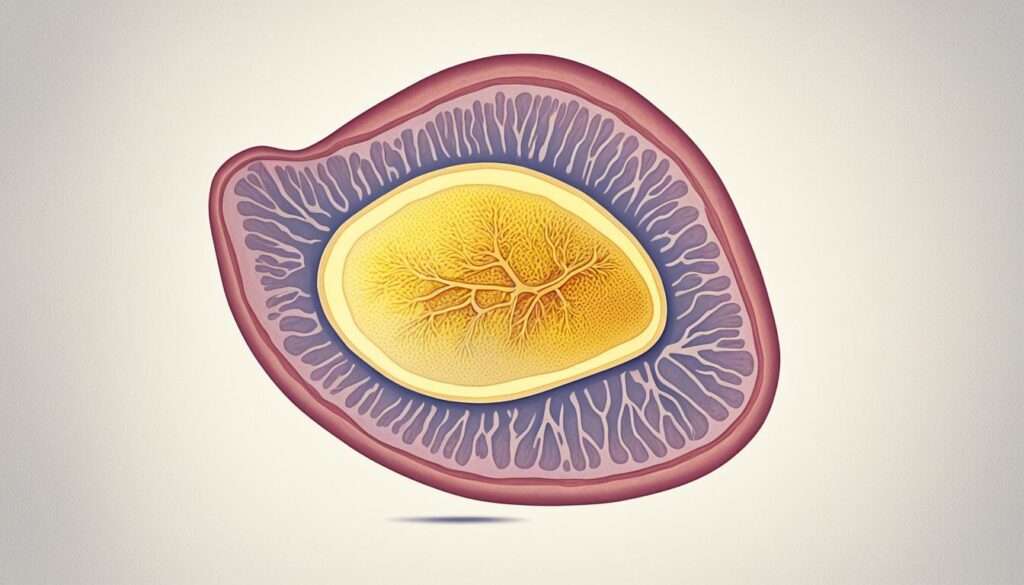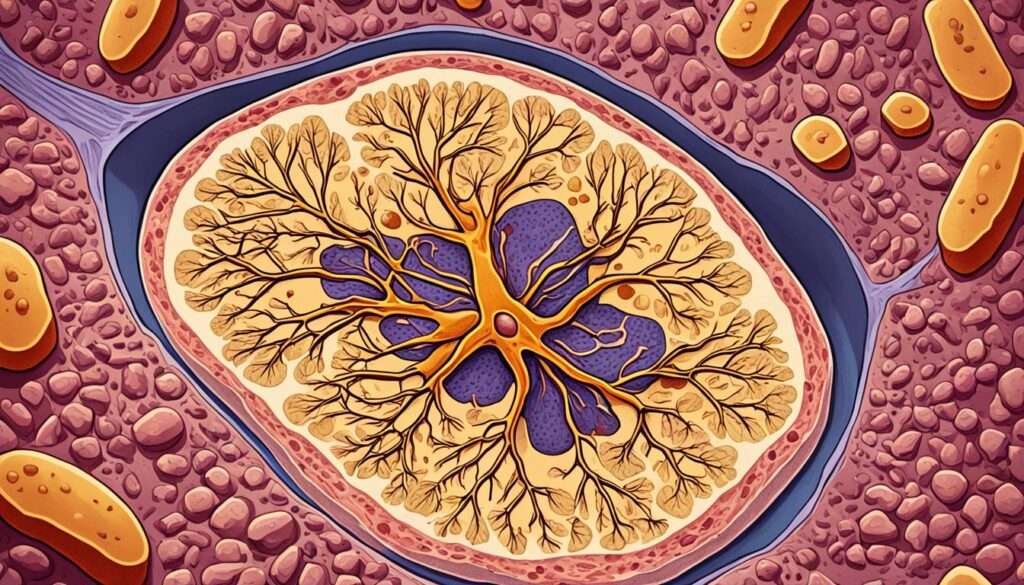Diffuse hepatic steatosis, also known as fatty liver, is a common issue. It happens when there’s too much fat in the liver cells. This makes it hard to see the liver clearly, especially if there are some fatty areas missing.
Table of Contents
ToggleAbout 25% of people have this condition, and it often has no clear cause. But, it can come from drinking too much alcohol, or from conditions like non-alcoholic fatty liver disease (NAFLD). Other causes include insulin resistance, diabetes, being overweight, and high cholesterol.
Doctors need to understand diffuse hepatic steatosis well. It’s important for the health of the liver and the whole body. We’ll look into what it is, how common it is, what causes it, how it looks on scans, how serious it can be, and how to manage it.
What Is Diffuse Hepatic Steatosis?
Diffuse hepatic steatosis is a condition where too much fat builds up in the liver. This happens when the liver cells, called hepatocytes, store more lipids, mainly triglycerides, than usual. It’s a common issue, affecting about 25% of people.
The liver looks bigger, yellow, and feels greasy in those with this condition.
Definition and Prevalence
At its core, diffuse hepatic steatosis means a lot of fat is stored in the liver. It’s a common issue, hitting around 25% of the population.
This buildup of fats, especially triglycerides, in liver cells is key to the condition. It makes the liver look bigger, yellow, and feel greasy.
| Characteristic | Description |
|---|---|
| Definition | Widespread accumulation of fat within the liver |
| Prevalence | Affects approximately 25% of the population |
| Macroscopic Appearance | Enlarged, yellow, and greasy liver |

Causes of Diffuse Hepatic Steatosis
Diffuse hepatic steatosis means the liver has too much fat. It often happens because of alcohol abuse or non-alcoholic fatty liver disease (NAFLD).
Alcohol Abuse
Drinking too much alcohol can cause this condition. It leads to fat building up in the liver, causing inflammation and damage. This is called alcoholic fatty liver disease and can get worse if not treated.
Non-Alcoholic Fatty Liver Disease (NAFLD)
Non-alcoholic fatty liver disease (NAFLD) is another main cause. It’s linked to insulin resistance, diabetes, obesity, and high blood fat. If not managed, it can turn into a more serious condition called metabolic dysfunction-associated steatohepatitis (MASH).
Knowing what causes diffuse hepatic steatosis helps in treating it. Doctors can create plans to help patients keep their liver healthy. This way, they can avoid serious problems.
Imaging Features
Diffuse hepatic steatosis, or fatty liver disease, can be spotted and checked with different imaging methods. These methods give important details about the condition’s spread and nature. They help doctors make precise diagnoses and plan treatments.
Ultrasound Findings
Ultrasound shows the liver in people with diffuse hepatic steatosis as very bright. This means it’s more echoic than normal liver tissue. The sound waves also seem to fade as they go through the fatty liver. The kidneys might look darker compared to the liver, showing the liver is fatty.
CT Findings
CT scans are also used to look at diffuse hepatic steatosis. The liver looks less dense on a CT scan. It’s at least 10 Hounsfield units (HU) less dense than the spleen. This is a sign of fat in the liver.
MRI Findings
MRI is a top choice for checking diffuse hepatic steatosis. It uses in-phase and out-of-phase imaging. This shows a signal drop on out-of-phase images, which means there’s fat in the liver.
Imaging tools like ultrasound fatty liver, CT fatty liver, and MRI fatty liver are key in spotting and diagnosing diffuse hepatic steatosis imaging. They give doctors the info they need to manage the condition well.
Grading of Diffuse Hepatic Steatosis
Diffuse hepatic steatosis, or fatty liver, can be graded by how much fat is in the liver. There are different ways to measure this, like looking at liver images on CT scans or MRI. These methods help doctors see how severe the condition is.
Knowing the grade of fatty liver helps doctors decide what to do next. Let’s look at the main ways to grade this condition:
- Mild Fatty Liver: This stage shows a liver-to-spleen ratio of 0.9 to 1.0 on CT scans. Or, it shows a signal loss of less than 33% on MRI.
- Moderate Fatty Liver: Here, the liver-to-spleen ratio on CT is 0.6 to 0.9. Or, the MRI shows a signal loss between 33% and 66%.
- Severe Fatty Liver: This is when the liver-to-spleen ratio on CT is under 0.6. Or, the MRI shows more than 66% signal loss.
| Grading of Diffuse Hepatic Steatosis | CT Liver-to-Spleen Ratio | MRI Signal Intensity Loss |
|---|---|---|
| Mild Fatty Liver | 0.9 to 1.0 | Less than 33% |
| Moderate Fatty Liver | 0.6 to 0.9 | 33% to 66% |
| Severe Fatty Liver | Less than 0.6 | Greater than 66% |
It’s important for doctors to understand how to grade diffuse hepatic steatosis. This helps them choose the best treatment and keep an eye on how the condition changes or gets better.

liver diffuse hepatic steatosis
Liver diffuse hepatic steatosis, also known as fatty liver disease, comes in two main types. These are alcohol-related liver disease (ALD) and metabolic dysfunction-associated steatotic liver disease (MASLD). Knowing the differences between them is key for proper diagnosis and treatment.
Alcohol-Related Liver Disease (ALD)
ALD happens when someone drinks too much alcohol, causing fat to build up in the liver. This can lead to serious health issues like cirrhosis and liver failure. To manage ALD, it’s important to cut down on alcohol and seek medical help.
Metabolic Dysfunction-Associated Steatotic Liver Disease (MASLD)
MASLD, also known as non-alcoholic fatty liver disease (NAFLD), is caused by metabolic issues like obesity, insulin resistance, and high cholesterol. It’s becoming more common due to the rise in obesity and lack of exercise. Treating these metabolic problems is key to managing MASLD and preventing serious liver damage.
| Characteristic | Alcohol-Related Liver Disease (ALD) | Metabolic Dysfunction-Associated Steatotic Liver Disease (MASLD) |
|---|---|---|
| Cause | Excessive alcohol consumption | Metabolic risk factors (obesity, insulin resistance, dyslipidemia) |
| Prevalence | Closely linked to alcohol abuse patterns | Increasing due to the global rise in obesity and sedentary lifestyles |
| Progression | Can lead to cirrhosis and liver failure | Can progress to non-alcoholic steatohepatitis (NASH) and advanced liver disease |
| Management | Reducing alcohol intake and addressing underlying health issues | Addressing metabolic risk factors, such as weight loss and lifestyle changes |
It’s important for doctors to know the differences between ALD and MASLD for accurate diagnosis and treatment. By understanding these conditions, patients can get the right care and support for their liver health.

Complications and Progression
If not treated, diffuse hepatic steatosis can turn into serious liver issues. For those who drink too much alcohol, fatty liver can become more severe. This can lead to liver failure and other serious problems.
For people with metabolic-related fatty liver, the disease can get worse. It can move from simple fatty liver to a more serious condition called metabolic dysfunction-associated steatohepatitis (MASH). This stage includes inflammation, tissue damage, and can lead to fibrosis and cirrhosis.
At these advanced stages, the risk of liver cancer and needing a liver transplant goes up. It’s important to treat diffuse hepatic steatosis early. This can stop or slow down the disease from getting worse.
| Condition | Progression | Potential Complications |
|---|---|---|
| Alcohol-Related Liver Disease (ALD) | Fatty liver -> Alcoholic hepatitis -> Alcoholic cirrhosis | Liver failure, other life-threatening complications |
| Metabolic-Associated Fatty Liver Disease (MAFLD) | Fatty liver -> Metabolic dysfunction-associated steatohepatitis (MASH) -> Fibrosis -> Cirrhosis | Liver cancer, need for liver transplantation |
It’s key to catch and treat diffuse hepatic steatosis early. This can stop fatty liver disease from getting worse. By tackling the root causes and using the right treatments, people can lower the risk of severe liver problems.
Diagnosis and Treatment
Diagnosing diffuse hepatic steatosis is a detailed process. It includes a full medical history, physical check-up, and various tests. These steps help doctors find the cause and how severe it is.
Diagnostic Approach
The first step is reviewing your medical history and checking your symptoms. Your doctor will also look for signs of liver issues during a physical exam.
Blood tests are key in diagnosing fatty liver disease. They check liver enzyme levels, which might be high if you have fatty liver. These tests also help rule out other conditions that could cause liver fat buildup.
Imaging like ultrasound, CT, and MRI is important too. These scans show how much fat is in your liver. They help doctors plan your treatment.
Sometimes, a liver biopsy is needed to confirm the diagnosis and see how bad it is. This involves taking a small liver sample for analysis. It helps tell apart different liver diseases and guides treatment.
Your doctor uses your medical history, physical exam, blood tests, and scans to make a correct diagnosis. Then, they create a treatment plan that fits your needs.
Management Strategies
Managing fatty liver disease, also known as diffuse hepatic steatosis, needs a full plan. This plan looks at the main causes. The main ways to treat it depend on the type of fatty liver you have. This could be alcohol-related (ALD) or non-alcoholic (NAFLD).
If you have ALD, stopping alcohol use is key. Not drinking alcohol can help fix the liver damage and stop more harm. For NAFLD, losing weight by eating better and moving more is vital. This helps lower liver fat and stops the disease from getting worse.
Sometimes, you might need medicine or other treatments for fatty liver. For example, vitamin E can help with non-alcoholic steatohepatitis (NASH). The new drug remetirom is also approved for NAFLD. Your doctor will create a plan just for you, based on your needs and the cause of your fatty liver.
No matter the type of fatty liver you have, focusing on the main cause is important. Working with your healthcare team and changing your diet, exercise, and maybe taking medicine can help. This way, you can manage your fatty liver and lower the risk of serious problems.
Conclusion
Fatty liver disease, also known as diffuse hepatic steatosis, is a common health issue. It happens when too much fat builds up in the liver. This can come from drinking too much alcohol or metabolic issues like being overweight and resistant to insulin.
If not treated, it can lead to more serious liver problems. These include inflammation, fibrosis, and cirrhosis. To manage it, doctors use medical history, blood tests, and imaging studies to diagnose it.
Dealing with the root cause is key. This might mean stopping alcohol use, losing weight, or other treatments. Taking action early can prevent serious liver issues and keep your liver healthy.
The latest medical treatments, like resmetirom, offer hope for severe cases. This shows the need for teamwork between doctors and patients to tackle this issue. By being informed and active, you can manage your fatty liver and keep your liver healthy for a long time.
FAQ
What is diffuse hepatic steatosis?
Diffuse hepatic steatosis, also known as fatty liver, is when the liver stores too much fat. This makes it hard to see the liver clearly, especially with focal fatty sparing.
How prevalent is diffuse hepatic steatosis?
About 25% of people have diffuse hepatic steatosis. It’s often not caused by anything specific but can be linked to alcohol use, NAFLD, diabetes, obesity, and other health issues.
What are the main causes of diffuse hepatic steatosis?
It can be caused by drinking too much alcohol or by non-alcoholic fatty liver disease (NAFLD). NAFLD is linked to insulin resistance, diabetes, being overweight, and high cholesterol.
How can diffuse hepatic steatosis be detected and evaluated?
Doctors use ultrasound, CT, and MRI scans to find and measure liver fat. These tests show how much fat is in the liver.
How is diffuse hepatic steatosis graded?
Doctors grade it by how much fat is in the liver. They use CT scans or MRI to see the liver’s fat level.
What are the main types of diffuse hepatic steatosis?
There are two main types: alcohol-related liver disease (ALD) and metabolic dysfunction-associated steatotic liver disease (MASLD), also known as NAFLD.
What are the potential complications of diffuse hepatic steatosis?
It can turn into more serious issues like inflammation, fibrosis, and cirrhosis. These can raise the risk of liver cancer and the need for a liver transplant.
How is diffuse hepatic steatosis diagnosed?
Doctors use a mix of methods like medical history, physical check-up, blood tests, and imaging like ultrasound, CT, and MRI. Sometimes, a liver biopsy is needed.
How is diffuse hepatic steatosis managed?
Treatment aims at the root cause. This might mean stopping alcohol use, losing weight, or other treatments to prevent serious liver problems.
Source Links


